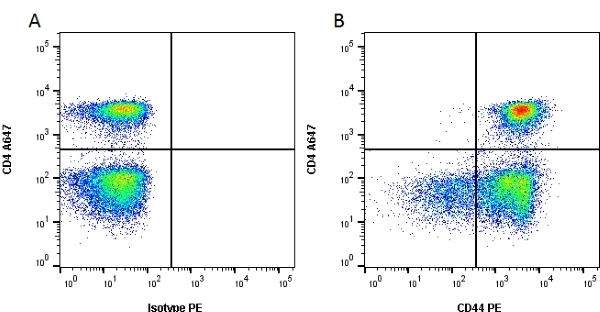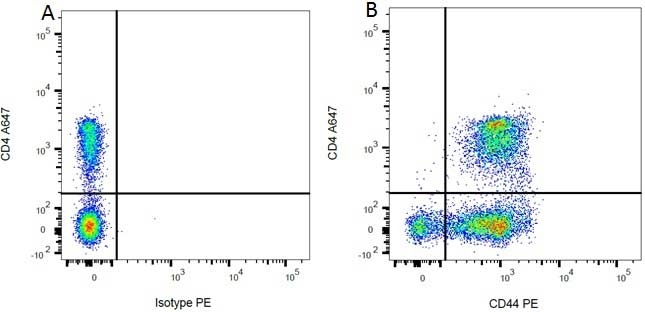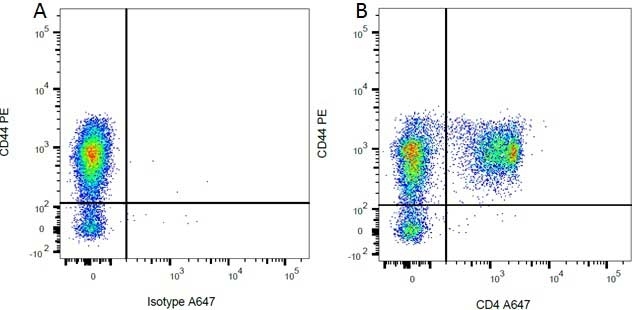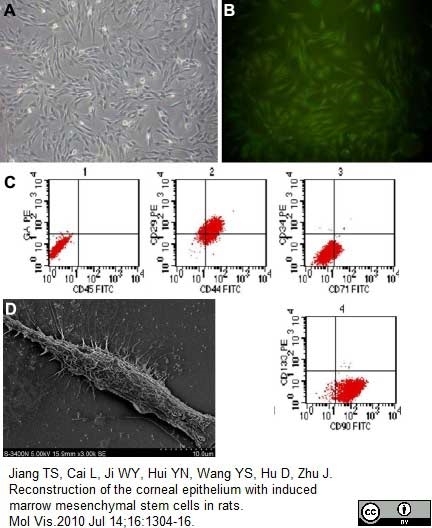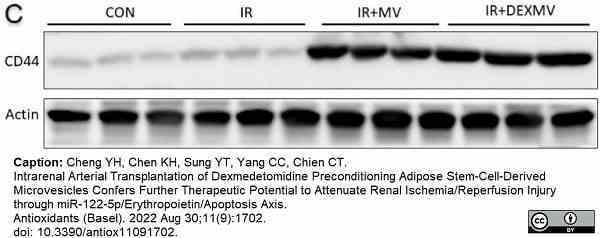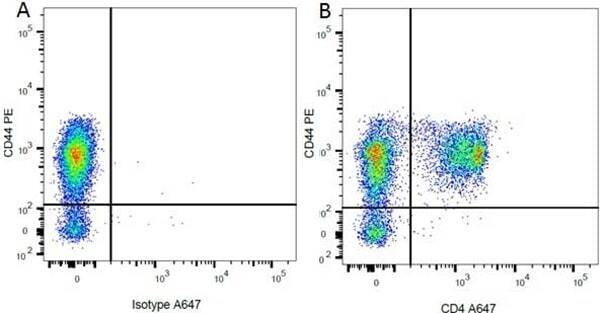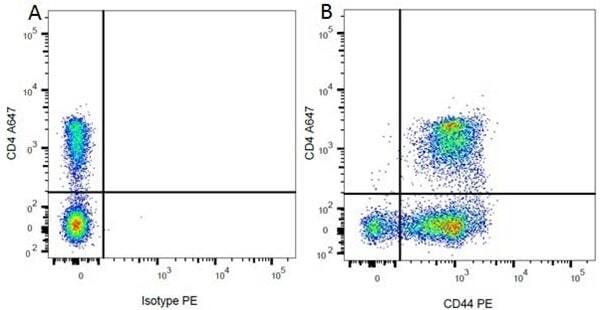CD44 antibody | OX-50







Mouse anti Rat CD44:RPE
- Product Type
- Monoclonal Antibody
- Clone
- OX-50
- Isotype
- IgG1
- Specificity
- CD44
| Mouse anti Rat CD44 antibody, clone OX-50 recognizes the rat CD44 cell surface antigen, also known as Extracellular matrix receptor III, P90 lymphocyte homing/adhesion receptor, HUTCH-I, Hermes antigen, Hyaluronate receptor, Phagocytic glycoprotein 1, PGP-1 or Phagocytic glycoprotein I. CD44 is a 482 amino acid ~85 kDa single pass type I transmembrane glycoprotein, expressed by T cells, B cells, macrophages and thymocytes, with expression being increased following activation. |
- Target Species
- Rat
- Product Form
- Purified IgG conjugated to R. Phycoerythrin (RPE) - lyophilized
- Reconstitution
- Reconstitute with 1 ml distilled water
- Preparation
- Purified IgG prepared by affinity chromatography on Protein A from tissue culture supernatant
- Buffer Solution
- Phosphate buffered saline
- Preservative Stabilisers
0.09% Sodium Azide 1% Bovine Serum Albumin 5% Sucrose - Immunogen
- Rat T cell blasts.
- Fusion Partners
- Spleen cells from immunised BALB/c mice were fused with cells of the mouse NS0/1 myeloma cell line.
- Max Ex/Em
-
Fluorophore Excitation Max (nm) Emission Max (nm) RPE 488nm laser 496 578 - Regulatory
- For research purposes only
- Guarantee
- 12 months from date of despatch
DO NOT FREEZE.
This product should be stored undiluted. This product is photosensitive and should be protected from light. Should this product contain a precipitate we recommend microcentrifugation before use.
| Application Name | Verified | Min Dilution | Max Dilution |
|---|---|---|---|
| Flow Cytometry | Neat |
- Flow Cytometry
- Use 10ul of the suggested working dilution to label 106 cells in 100ul.
How to Use the Spectraviewer
Watch the Tool Tutorial Video ▸- Start by selecting the application you are interested in, with the option to select an instrument from the drop down menu or create a customized instrument
- Select the fluorophores or fluorescent proteins you want to include in your panel to check compatibility
- Select the lasers and filters you wish to include
- Select combined or multi-laser view to visualize the spectra
| Description | Product Code | Applications | Pack Size | List Price | Your Price | Quantity | |
|---|---|---|---|---|---|---|---|
| Mouse IgG1 Negative Control:RPE | MCA1209PE | F | 100 Tests | Log in | |||
| List Price | Your Price | ||||||
| Log in | |||||||
| Description | Mouse IgG1 Negative Control:RPE | ||||||
References for CD44 antibody
-
Stevenson, K.S. et al. (2009) Isolation, characterization, and differentiation of thy1.1-sorted pancreatic adult progenitor cell populations.
Stem Cells Dev. 18:1389-98. -
Jiang, T.S. et al. (2010) Reconstruction of the corneal epithelium with induced marrow mesenchymal stem cells in rats.
Mol Vis. 16: 1304-16. -
Kanellis, J. et al. (2010) JNK signalling in human and experimental renal ischaemia/reperfusion injury.
Nephrol Dial Transplant. 25: 2898-908. -
Li, S. et al. (2010) Upregulation of CXCR4 favoring neural-like cells migration via AKT activation.
Neurosci Res. 67: 293-9. -
Stephens, L.A. et al. (2004) Phenotypic characterization of regulatory CD4+CD25+ T cells in rats.
Int Immunol. 16: 365-75. -
Rice, C.M. et al. (2010) Multipotent adult progenitor cell isolation and proliferation in cytokine and serum-free medium conditioned by rat B104 cells.
Br J Haematol. 148: 441-4. -
Carulli, D. et al (2006) Composition of perineuronal nets in the adult rat cerebellum and the cellular origin of their components.
J Comp Neurol. 494: 559-77. -
Galtrey, C.M. et al. (2008) Distribution and synthesis of extracellular matrix proteoglycans, hyaluronan, link proteins and tenascin-R in the rat spinal cord.
Eur J Neurosci. 27: 1373-90.
View The Latest Product References
-
Hofmann, N. et al. (2002) Increased expression of ICAM-1, VCAM-1, MCP-1, and MIP-1 alpha by spinal perivascular macrophages during experimental allergic encephalomyelitis in rats.
BMC Immunol. 3: 11. -
Walther, M. et al. (2001) Exogenous antigen containing perivascular phagocytes induce a non-encephalitogenic extravasation of primed lymphocytes.
J Neuroimmunol. 117: 30-42. -
Suzuki, A. et al. (2006) Localization of CD44 and hyaluronan in the synovial membrane of the rat temporomandibular joint.
Anat Rec A Discov Mol Cell Evol Biol. 288: 646-52. -
Goransson, V. et al. (2004) Renal hyaluronan accumulation and hyaluronan synthase expression after ischaemia-reperfusion injury in the rat.
Nephrol Dial Transplant.19: 823-30. -
Campbell, N.G. et al. (2016) Cell Size Critically Determines Initial Retention of Bone Marrow Mononuclear Cells in the Heart after Intracoronary Injection: Evidence from a Rat Model.
PLoS One. 11 (7): e0158232. -
Bejar, M.T. et al. (2016) Inhibition of Notch rescues the angiogenic potential impaired by cardiovascular risk factors in epicardial adipose stem cells.
FASEB J. 30 (8): 2849-59. -
Rochefort, G.Y. et al. (2006) Multipotential mesenchymal stem cells are mobilized into peripheral blood by hypoxia.
Stem Cells. 24 (10): 2202-8. -
Redondo, J. et al. (2015) Reductions in kinesin expression are associated with nitric oxide-induced axonal damage.
J Neurosci Res. 93 (6): 882-92. -
Huang, X. et al. (2019) MRI Tracking of SPIO- and Fth1-Labeled Bone Marrow Mesenchymal Stromal Cell Transplantation for Treatment of Stroke.
Contrast Media Mol Imaging. 2019: 5184105. -
Aminzadeh, A. et al. (2020) Investigating The Alterations of Oxidative Stress Status, Antioxidant Defense Mechanisms, MAP Kinase and Mitochondrial Apoptotic Pathway in Adipose-Derived Mesenchymal Stem Cells from STZ Diabetic Rats.
Cell J. 22 (Suppl 1): 38-48. -
Paiva, R.G. et al. (2020) Stem cells in end-to-side neurorrhaphy. Experimental study in rats
Acta Cirúrgica Brasileira. 35 (12) [Epub ahead of print]. -
Hou, B. et al. (2018) Comparison of the Effects of BMSC-derived Schwann Cells and Autologous Schwann Cells on Remyelination Using a Rat Sciatic Nerve Defect Model.
Int J Biol Sci. 14 (13): 1910-22. -
Porwal, K. et al.kfz172 (2019) Increased bone marrow-specific adipogenesis by clofazimine causes impaired fracture healing, osteopenia and osteonecrosis without extra-skeletal effects in rats.
Toxicol Sci. kfz172. -
Chang, H.H. et al. (2019) Intrarenal Transplantation of Hypoxic Preconditioned Mesenchymal Stem Cells Improves Glomerulonephritis through Anti-Oxidation, Anti-ER Stress, Anti-Inflammation, Anti-Apoptosis, and Anti-Autophagy.
Antioxidants (Basel). 9 (1): 2. -
Wu, J. et al. (2022) Reinforcing the function of bone graft via the Ca-P ceramics dynamic behavior-enhanced osteogenic microenvironment for optimal bone regeneration and reconstruction
Applied Materials Today. 27: 101465. -
Cheng, Y.H. et al. (2022) Intrarenal Arterial Transplantation of Dexmedetomidine Preconditioning Adipose Stem-Cell-Derived Microvesicles Confers Further Therapeutic Potential to Attenuate Renal Ischemia/Reperfusion Injury through miR-122-5p/Erythropoietin/Apoptosis Axis.
Antioxidants (Basel). 11(9): 1702.
- Synonyms
- H-CAM
- PGP-1
- RRID
- AB_321723
- UniProt
- P26051
- Entrez Gene
- Cd44
- GO Terms
- GO:0001558 regulation of cell growth
- GO:0001955 blood vessel maturation
- GO:0007155 cell adhesion
- GO:0016021 integral to membrane
- GO:0004872 receptor activity
- GO:0005540 hyaluronic acid binding
- GO:0005634 nucleus
- GO:0006954 inflammatory response
- GO:0014070 response to organic cyclic compound
- View More GO Terms
- GO:0016323 basolateral plasma membrane
- GO:0016324 apical plasma membrane
- GO:0016477 cell migration
- GO:0019901 protein kinase binding
- GO:0031175 neuron projection development
- GO:0033031 positive regulation of neutrophil apoptosis
- GO:0033189 response to vitamin A
- GO:0034238 macrophage fusion
- GO:0043234 protein complex
- GO:0051219 phosphoprotein binding
MCA643PE
If you cannot find the batch/lot you are looking for please contact our technical support team for assistance.
Please Note: All Products are "FOR RESEARCH PURPOSES ONLY"
View all Anti-Rat ProductsAlways be the first to know.
When we launch new products and resources to help you achieve more in the lab.
Yes, sign me up